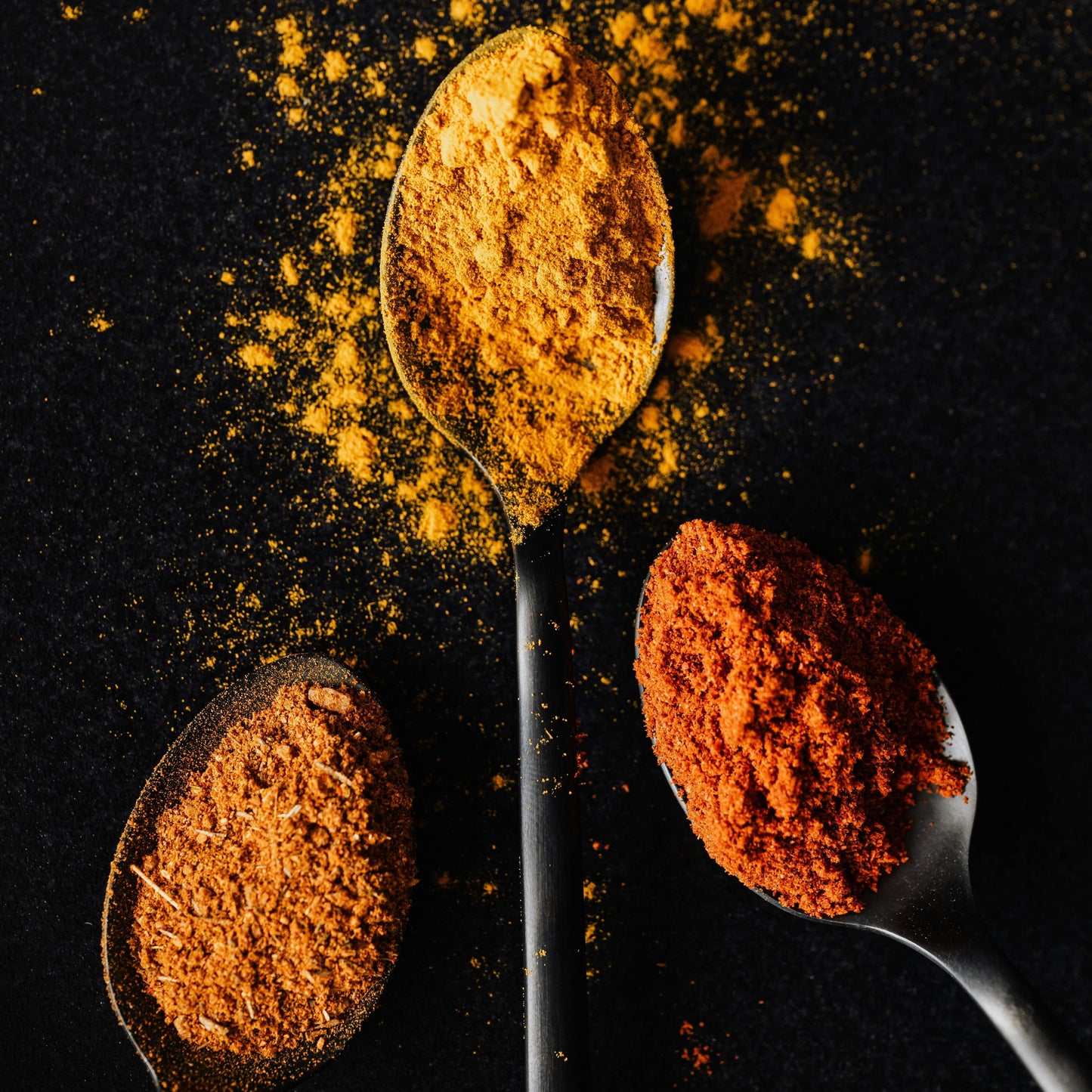Buy your weekday smoothies and get your weekend ones for free. (7 for the price of 5!)

Have you ever opened your spice cabinet and felt like something was missing? Maybe your dishes lack that punch, that spark of flavor that turns a good meal into an unforgettable one. That’s where custom spice blends come in. They’re the secret weapon of every great cook, and the best part is—you can make them at home. Not only is it fun, but when you use organic spices, you’re giving your meals a healthy, chemical-free upgrade.
The Benefits of Creating Your Own Spice Blends
Making spice blends at home isn’t just about taste—it’s about control.
-
Flavor on your terms: You decide how bold, mild, or aromatic you want it.
-
Healthier meals: No fillers, MSG, or preservatives—just pure spices.
-
Save money: Buying bulk organic spices and mixing them is far cheaper than buying pre-made blends.
-
Personal touch: Your blend, your style.
Imagine sprinkling your own unique creation on roasted chicken—it’s like signing your dish with a flavorful signature.
Essential Tools for Spice Blending at Home
You don’t need a fancy kitchen to make magic happen. Just a few tools:
-
Mortar and pestle for old-school grinding.
-
Spice grinder for speed and smooth textures.
-
Airtight jars to lock in freshness.
-
Labels (because trust me, turmeric looks a lot like curry powder when you forget).
Choosing the Right Organic Spices
When it comes to spices, quality matters. Always go organic when possible. Not only are they richer in flavor, but they’re also free from harmful pesticides.
Some must-haves include:
-
Cumin – earthy and warm
-
Turmeric – vibrant and healing
-
Paprika – smoky or sweet depending on the type
-
Cinnamon – sweet and spicy
-
Black pepper – sharp and versatile
Flavor Profiles and Pairing Basics
Think of spices like instruments in a band. Alone, they sound good. Together, they create music.
-
Sweet notes – cinnamon, nutmeg, cardamom
-
Savory notes – garlic, onion powder, oregano
-
Spicy notes – chili, cayenne, black pepper
-
Earthy notes – cumin, turmeric, coriander
The trick is balance. Too much chili, and your blend becomes a fire hazard. Too little, and it’s bland.
Classic Homemade Organic Spice Blends
Start with the basics:
-
Garam Masala – a warming Indian mix of cumin, coriander, cardamom, and cloves.
-
Herbes de Provence – floral and savory, perfect for roasting chicken or veggies.
-
Taco Seasoning – chili powder, cumin, paprika, garlic, and oregano.
-
Curry Powder – a golden mix of turmeric, coriander, cumin, and ginger.
Innovative and Unique Spice Blend Ideas
This is where things get exciting:
-
Citrus-Chili Fusion: Lemon zest + chili flakes = tangy and hot.
-
Lavender & Rosemary Rub: Perfect for lamb or roasted potatoes.
-
Smoked Paprika Cocoa Mix: A smoky, slightly chocolatey rub for steak.
-
Turmeric-Ginger Immune Booster: Add to teas, soups, or smoothies.
Spice Blends for Everyday Cooking
Want breakfast to pop? Sprinkle a cinnamon-ginger blend on oatmeal.
Salads? Whip up a herb-citrus vinaigrette mix.
Grilling night? A garlic-smoked paprika rub works wonders on veggies and meat.
Health-Focused Spice Mixes
Food should heal as much as it delights. Try these:
-
Anti-inflammatory blend: Turmeric + ginger + black pepper.
-
Digestion support blend: Fennel + cumin + coriander.
-
Stress-relief herbal blend: Chamomile + lavender + cardamom.
Tips for Crafting Your Signature Blend
-
Start with small batches (nobody wants a gallon of a failed experiment).
-
Take notes—write down every measurement.
-
Taste, tweak, repeat.
How to Store and Preserve Homemade Spice Mixes
Spices hate air, light, and moisture. Store them in airtight jars, label them with the date, and use them within 6 months for maximum freshness.
Creative Uses of Spice Mixes Beyond Cooking
Your blends don’t have to stay in the kitchen.
-
Spiced teas and lattes – think chai!
-
DIY body scrubs – sugar + cinnamon + coconut oil.
-
Natural air fresheners – simmer cloves, cinnamon, and orange peel in water.
Common Mistakes to Avoid When Blending Spices
-
Using stale spices—they lose potency fast.
-
Going overboard with strong flavors like clove.
-
Not testing blends before making big batches.
Experimenting with Global Inspiration
Why stop at your comfort zone?
-
Middle Eastern Za’atar – thyme, sesame, sumac.
-
African Berbere – chili, garlic, ginger, fenugreek.
-
Asian Five-Spice – star anise, fennel, cinnamon, cloves, pepper.
Conclusion
Crafting custom organic spice blends at home is like painting with flavors. You get to control every note, avoid chemicals, and add a personal touch to every dish. With a little practice, your spice cabinet won’t just be full—it’ll be your secret arsenal of flavor.
FAQs
1. How long do homemade spice blends last?
Usually 3–6 months if stored in airtight jars away from heat and light.
2. Can I use fresh herbs instead of dried?
Yes, but they’ll shorten the shelf life. Use them for immediate blends like marinades.
3. What’s the best way to grind spices?
A spice grinder is fastest, but a mortar and pestle gives you better control.
4. Do organic spices really make a difference?
Absolutely. They’re more flavorful, richer in oils, and free from harmful chemicals.
5. Can I create blends without salt?
Yes! Many spice mixes are salt-free, letting you season to taste later.